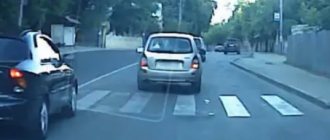Car owners love tinted front windows, as it reduces the amount of sunlight in the cabin and the strength of the rays of oncoming cars. Tinted windows further improve the appearance of the car and provide some protection from prying eyes. Only the President and the head of the Cabinet of Ministers can move with full tinting. For other residents, the standards specified in the legislation apply. What tinting is allowed on front windows, and what kind of tinting the traffic police patrols find fault with, we will look at in the article.
What kind of tinting is allowed on the windshield: we understand the standards
At the beginning of 2015, the level of permeability into the cabin through the windshield was regulated by GOST 5727-88. During its operation (since the early 90s), 4 amendments were made. The latest version has been in effect since 2002. According to the law, tinting on car door windows and windshields must meet the following requirements:
- light transmittance of windshields is 75% or higher. It was allowed to install a light-protective strip in the frontal part; its width was also regulated by GOST (calculated using a formula), more often it was less than 15 cm. The calculation was based on the height for unhindered operation of the wipers, the required viewing angle and regulatory zones;
- non-windshields, referred to as so-called, can be tinted to protect against rays by no more than 30%;
- For other non-windshields, the standards do not have clear recommendations.
Car tinting according to GOST
Starting from January 1, 2015, adjustments were made to the technical regulations; now tinting is standardized by GOST 32565-2013. Legislation has reduced light transmission standards to 70% (5% lower than the previous figure). Thanks to changes in regulations, tinting with athermal film, which has been especially popular in recent years, has been legalized.
Similar requirements are included in another document - the technical regulations of the Customs Union. When crossing the border with the countries of the Customs Union, you don’t have to worry about fines or problems at checkpoints.
It is worth adding to the answer what kind of tinting can be used to tint the front windows, since the innovation sets a rigid size for the shading strip, now it is 140 mm. No standards have been developed regarding light transmission. Additionally, the side windows have been divided into:
- type 1 – create a view from the front;
- type 2 - create rear visibility.
Distribution into categories is made based on the principles of geometric distribution of the body. The “R point” (so-called) should be installed on the driver’s seat from the factory. By drawing a vertical line through a point perpendicular to the longitudinal median plane of the car, it is possible to divide the car into 2 parts. The front half with glass belongs to the first category, and the second to class 2.
Light transmission of glass according to GOST
The new standards have not changed the parameters of what kind of tinting can be used to tint the front windows - the amount of light after measurement should be 70% or higher. If the design of the car is equipped with 2 external rear-view mirrors, any film can be applied to the glass of category 2, since the corresponding standards have not been developed.
The traffic regulations allowed the installation of curtains on the rear window of a car or the side windows of a bus. It turns out that the permissible tinting of the rear window reaches complete impenetrability.
Is it possible to obtain permission to tint and how?
Today, the fight against tinting in our country is becoming increasingly tougher - immediately after the cancellation of license plates for tinted windows, so-called demands or orders to eliminate the violation were used, after which drivers were imprisoned for up to 15 days. Moreover, a change is coming in the legislation to toughen penalties for tinting windows “not in accordance with GOST”, up to and including deprivation of rights. But this is in the future, and now we will consider the issue of permitted tinting, namely, the opportunity to earn money for health reasons, buy or otherwise obtain permission to tint in 2021.
The issue is that in some cases and certain categories of drivers, for a variety of reasons, exceptions to the law can be allowed, and there are such exceptions in a variety of other aspects of the law. So, let's answer the question whether and how you can get a special permit for tinting, what law regulates this, is it available to mere mortal drivers and what is needed for this in 2021.
Permission to tint - method No. 1:
Firstly, the easiest way to get permission to tint is to tint “according to GOST”. The fact is that tinting in our country is not prohibited in principle (except for mirror tinting), but there are standards for light transmittance and what kind of glass is allowed to be tinted. Namely, the front “hemisphere” can be tinted so that it transmits at least 70% of all light. This, of course, is very little, taking into account the fact that already from the factory the light transmittance of glass (and it is not even tinted) is 85-95%. Literally, the glass will become only a little darker, and if your goal when tinting is to become invisible, to significantly hide from the sun, then this legal method will not suit you.
However, if your goal is to protect yourself from the summer heat and apply athermal film, then we have good news for you - a number of athermal films (but not all) are tested for light transmittance.
Thus, you already have a kind of permission to tint - it is provided by law with the only compelling condition that the tint must transmit 70% of the light into the car.
Permission to tint - method No. 2:
Another method is much less effective, but, in any case, more useful than simply tinting the car and driving like that. The method is to know the loopholes in the legislation due to the “holes”, and there are plenty of them. We will not cite here all the shortcomings of Russian legislation regarding tinting that allow it one way or another, we will only note that they are all divided into main categories:
- Shortcomings in basic laws: traffic rules, administrative code . Thus, the Traffic Rules, when tinting is permitted, refers us to GOST 5727-88, which has long lost force, and in general GOSTs became optional after the introduction of Technical Regulations. The same Code of Administrative Offenses in the article with punishment for tinting (12.5.3.1) refers to a document called “Technical Regulations for the Safety of Wheeled Vehicles”, which has also lost force, and in its place a document similar in content is in force, but already called “Technical Regulations” Customs Union for the safety of wheeled vehicles." And there are many more such shortcomings.
- Shortcomings in the procedures for determining light transmittance themselves . Thus, the determination device must have a verification certificate, and the measurement must be carried out strictly according to the instructions for the device. In fact, it is because of procedural errors in the glass measurement process that errors are made among inspectors, which can lead to the cancellation of the decision. In addition, there are a number of “life hacks” that cease to work over time and are replaced by others during the measurement process. For example, remove the removable tint while the inspector goes to get the device, lower the windows and declare that the window regulator is broken, and so on.
- Cancellation of decisions upon expiration of deadlines in court . Here it is a little more complicated and simpler at the same time - you are simply stalling for time through various types of petitions, challenges, and so on, and it becomes impossible to prosecute for tinting for the simple reason that the statute of limitations has expired.
It should be clearly noted here that, firstly, you will not learn these methods in two or three days or even in two or three weeks. Rather, you will have to learn full-fledged legal knowledge in order to be able to operate the laws in your favor, because we must not forget that you are violating and you must prove the opposite, which is quite difficult. Second, judges and police officers are not stupid, and both of these government officials are allowed to make decisions about guilt based on their personal beliefs, which means that minor procedural errors are unlikely to play a significant role in appealing a tint ruling.
Well, in the end, it is worth noting that this is not permission to tint as such - it is only an opportunity to defend your rights in the event of a mutual violation by government officials.
There is also another hypothetical way to get permission for tinting - to have a “blat” in the traffic police, and among the highest ranks. We will not discuss this method due to its illegality and, of course, mythical nature. However, there is an opinion that, having received “connections” in the structures, it is possible to obtain permission to tint.
There are no other legal ways to buy or otherwise obtain permission to tint from the traffic police.
Previously, another myth spread: supposedly, if you get a certificate from a doctor stating that the driver has a special eye disease with impaired vision and pain in the eyes due to bright sunlight, then with such a certificate you will be allowed to tint the car. However, in 2021 this is indeed a myth, and it will be impossible to obtain permission to tint car windows with such a certificate. And there is some logic in this - after all, to solve the problem of immunity to bright sunlight, it is enough to wear sunglasses.
Permitted tinting of car windows: what is allowed and what is not?
With changes in legislation, the state actually legalized front window tinting using films. GOST uses the designation of glass with an acceptable polymer layer, but does not mention film. Tinting must comply with 3 documents: traffic rules, technical regulations of the vehicle and GOST 32565. Now we can confidently answer whether it is possible to tint a windshield - yes, both using spraying and film.
Especially a lot of ambiguity has arisen regarding mirror tinting. GOST does not directly indicate what kind of tinting can be glued to the front windows, but CU regulations clause 4.5 prohibits the installation of auto glass with a mirror coating. Additionally, the ban from the standard continues to apply since 1993, which establishes a list of rules for admitting vehicles to operation. Tinting side windows or rear windows with mirror film leads to the risk of an accident, because the light is reflected from the coating and blinds.
It is precisely established what percentage of tinting is allowed on front windows - 70% light transmission and more. For the sides, the percentage is regulated similarly - 70%. The permitted coefficient for the rear windows is not specified, as is the case for the rear doors, but when creating a darkness of less than 60%, the film somewhat reflects the light, creating a mirror effect. It is preferable to use a darkening level of 60% or higher in combination with curtains.
Car tinting with mirror film
How to darken a rear window
The tinting of the rear windows is no different from the windshields. To give a unique shape, a template is made and glued to a pre-treated surface.
Shields with heating threads should be passed with a scraper in a horizontal plane. This will protect the chain from damage and ensure a better fit of the tint. When carrying out work, you need to disconnect the plug going to the thread, and also remove the additional brake light.
Film template
Tinting the rear window begins with preparing a template. To do this you need:
- Cut material to fit.
- Apply to damp glass and smooth with a scraper.
- The corners are heated with a hairdryer and take the exact shape.
When making a template, it is important to lay the material with the adhesive layer facing up, otherwise, when gluing it to the inner surface, the corners will be bent in the other direction.
How to apply tint
Tinting the rear window is done using a squeegee, soap and water, or window cleaner. To protect the shelf from getting wet, you can cover it with a cloth.
Gluing tint to the rear window:
- Degrease the inside and wipe with a clean cloth.
- Inspect the surface for the presence of villi, hairs, and grains of sand.
- Treat the window with liquid.
- Tear off the transparent layer and apply the material to the glass.
- Wet the surface generously.
- Move the material in the desired direction, clearly matching the boundaries.
- Carefully remove the water using a rubber scraper.
Pasting is carried out without a hairdryer, since the template follows all the curves of the shield. After drying, you can install the brake light and return the plastic panels to their place.
Athermal tinting: allowed or not?
It's no secret that in the absence of film the car gets very hot. Even the presence of climate control does not show sufficient efficiency; passengers sweat.
Thanks to the inclusion of metal particles in the coating on glass, it is possible to achieve several advantages:
- the interior heats up more slowly;
- the need to use air conditioning is reduced;
- fuel consumption decreases;
- the atmosphere improves due to reduced gas emissions.
With strong darkness, the same effects occur, but there will be problems with the traffic police. When choosing what kind of tinting you can tint your front windows, you should take a closer look at the athermal material. When using athermal film, the interior remains clearly visible, the amount of light transmitted is about 90%, but it effectively reflects ultraviolet and infrared radiation, which leads to heating.
If you glue an athermal film to the windshield, you can improve the characteristics of the glazing and experience a number of advantages:
- gluing film is permitted by GOST, since the permissible percentage of 70% is observed, usually higher - 80-90%;
- the interior does not experience strong heating from the sun, as a result, the interior retains its new appearance for a long time;
Athermal tinting Lada Vesta
- at night the driver is protected from being blinded by oncoming cars;
- tinting improves the aesthetic perception of the car due to the transfusion effect;
- tinting helps to reduce the visibility of the interior from the outside.
An alternative option is to stick on one of the varieties of athermal material popularly called “chameleon”. The material changes the level of darkness depending on the lighting; on a clear day the film protects more, and on a cloudy day it blocks out less light. The selection rules are the same - the main condition is to maintain a permeability of at least 70%.
Why has the permitted percentage of tinting on front windows been reduced in the new GOST?
The light transmission of clean and completely new glass is not 100%, the maximum is 85%. If you take a standard film, most often the light transmission rate is 75%. If we take both indicators into account, the result will be: 0.85 * 0.75 = 0.64%. It turns out that film, by old standards, was always illegal.
The highest coefficient for the new film is 80-90%. According to basic calculations, installing film on the front glass was initially an illegal procedure. Taking into account the fact that with use the indicator decreases to 75-80%, the film always led to exceeding the normal limits. Light transmission can only be achieved by installing a light-colored film (90%) on new glazing (85%).
Formula: 0.9*0.85 = 76.5%.
Car front window tinting
In reality, it was almost impossible to tint the front car windows to achieve 75%. The indicator was always below the norm. For this reason, the percentage was reduced in GOST 32565-2013.
Tinting of the front side windows, as well as the windshield, is allowed, but a preliminary calculation is made of how much light will pass through, taking into account the indicator of the film, glass and deterioration during operation.
Allowed tinting in 2021?
So, first, let's look at what kind of car window tinting is allowed in 2021:
Width of tint strip on windshield
The first question that quite often interests drivers is the maximum width of the tinting strip on the top of the windshield. For passenger cars it is 14 centimeters .
Using film with 70% light transmittance
The second popular question is whether the driver will be fined for tinting if a film is applied to the windshield and front side windows, the light transmittance of which is exactly 70 percent.
To answer this question, one should take into account the fact that the light transmission of glass even in a new car does not reach 100 percent.
Let's look at an example. If the light transmission of the new glass is 95 percent, and the tinting film is 70 percent, then the final light transmission is calculated by the formula:
0.95 * 0.7 = 0.665 i.e. 66.5%
In practice, it does not matter whether a film is glued to the glass that transmits 70 percent or transmits 5 percent of light. Both options are the same violation and carry the same penalty.
Permitted tinting of front windows
Tinting the windshield and front side windows in itself is not prohibited. In this case, the only condition that must be taken into account is that the light transmission of tinted glass must be more than 70 percent .
In this case, you can try using a film with a light transmission of 85 to 95 percent.
Note. If you want to be sure that the tinting complies with current legislation, then after gluing the film, check the light transmission with a special device. Car service centers that specialize in working with car glass usually have such devices.
How to get permission to tint?
There is a common myth among drivers that in Russia it is possible to obtain a special permit for tinting , which allows you to tint your car with any film you like. The legislation does not provide for anything like this.
Note. If you see a tinted car on the street, this does not mean that its driver has a special permit. Most likely, the driver simply did not have time to get caught by the traffic police.
How to avoid being included in the list of those fined?
The most effective way to prevent a fine from being issued is to remove the tint completely, but this is an extreme option. A more conservative method is to lower the front side windows, but this can only be used in the summer.
The main problem is that full compliance with GOST standards is not 100% protection from receiving a fine. The risks are especially high for owners whose degree of tint is within acceptable limits, but approaches 70%. Devices for measuring light transmittance have operating errors; there is a high probability that the device will determine the glass as not meeting the standards.
There is an option to tint the glass with a light transmittance of 70-72% and avoid fines - take the permit with you. If there is an expert opinion, the traffic police should not find fault, but there are still no guarantees.
Fine for tinting car windows
The best way to protect yourself from a fine is to leave a gap of a few percent, then the suspicions of the traffic police will definitely be dispelled. If employees insistently demand measurements, your task is to demand careful compliance with all standards for using the device. Before checking, the air temperature and humidity level are determined. If the threshold is exceeded, the device will not provide reliable results.
When receiving readings that violate the requirements, the driver has the right to request a repeat measurement using another device. If the employee does not agree to repeat the procedure, a record of this is made in the protocol. Additionally, you can clarify the series and number of the device, and then appeal the results during the legal process. If the outcome is successful, an independent examination is appointed.
Penalty for incorrect tinting
Every driver should know the smallest details of imposing a fine for improper tinting of a car in order to be able to protect himself from illegal actions by traffic police officers:
- A fine is imposed only upon violation of GOST rules, regardless of the degree of violation.
- “Removable” tinting in the form of curtains and blinds on car windows does not exempt the violator of GOST on tinting from a fine.
- The law adopted in 2021 states that if a fine is paid within 20 days from the date of the decision on punishment, it is reduced by 50%. The law also applies to other motorist violations.
- The level of light transmittance of the film is indicated without taking into account the factors that influence changes in these parameters, because after applying tinting to the glass, its light transmittance may decrease significantly. With prolonged use of the film, it is rubbed off by the wipers, which also worsens the light transmission parameters.
This is interesting: Tuning a Honda Accord with photos
Previously, the use of incorrect tint was punishable by removal of the license plate and a ban on its use until the violation was corrected. Currently, such measures are not used, however, it is necessary to adhere to the law.
There are certain restrictions on the frequency of imposing fines. It is important to pay attention to the fact that the police officer, when drawing up a report, indicates the exact date and time. The law does not allow another fine for tinting to be issued less than 24 hours after the previous one. If 24 hours have not passed and the driver is stopped by another law enforcement officer, he must be presented with the existing protocol.
Only a court can impose additional penalties in the form of a fine or arrest. If you disobey the law and drive a car with incorrect tint after receiving a fine, the court may rule on deprivation of your license.
The fine for tinting front windows according to GOST in 2021 is 1,500 rubles. For repeated violation - 5,000 rubles. You can try to prevent a fine from being issued in the following ways:
- The tint can be removed right in front of the police officer, thereby avoiding fines.
- If, while checking the level of light transmittance, a police officer violates at least one of the above rules, he must be informed. In case of non-compliance with the rules for tinting control, the decision can be appealed in court.
- If the police report is completed incorrectly, you must immediately inform the officer about the error. There is a chance that the law enforcement officer will not draw up the document again and will release the driver.
- Ways to legally tint car windows.
What instruments measure the light transmittance of glass?
Light transmission measurements are carried out by an inspector. It is worth considering that the results always have an error, it is mostly insignificant, but if the rules of use are not followed, the deviation may increase. The results are affected by temperature, humidity and pressure.
The traffic police are armed with several types of devices:
- "Light". The light emitter and receiver are equipped with magnets, which makes the device easier to use. The rules indicate the need to take measurements at least 3 times. The real indicator is the arithmetic average of all measurements. The advantage of the device is its resistance to low temperatures;
Tonic device for checking tinting
- "Tonic". Both detectors have to be held manually, which often leads to errors. A mandatory requirement for correct measurement is strict coincidence of the marks on both sides of the device. Operates at temperatures from -10°C to 40°C;
- AKL-2M. Violation of the results occurs when the rubber gaskets do not fit tightly. The use of the device is permitted only at temperatures above 10°C.
The principle is the same in each case: the emitter is installed on one side, and the receiver on the other. When applying both elements to each other, the indicator should be 100%. If there is glass between them, the result will always be lower.
Correct results for each device are only obtained when attached to dry glass.
How to properly tint your front windows?
Most new cars come from the factory with windows that have about 80% light transmission. There is no need to apply film on modern cars. If you glue a film with a permeability of 90% on top of it, the indicators will already be on the acceptable side.
Any tint can be applied to the rear windows. To comply with the standards, it is recommended to leave the process of gluing and selecting film in the hands of professionals. At the tinting station, they also make sure that the permeability meets the standards.
Recommendations
If the applied film violates technical standards, it should be removed. There are several ways to remove old tint. To simplify the procedure, use a soap solution and a hair dryer.
If you want to tint your car, electric tinting may be a solution. It changes the level of light transmission depending on the user's wishes. The solution is convenient and effective, but expensive. An alternative is chameleon tinting; it independently changes permeability and costs less.
When choosing types of tinting, athermal film for cars is preferred; it prevents strong heating and maintains high light transmittance.
Car preparation
To perform high-quality car window tinting, you need to prepare the materials and the car in advance. A properly cleaned window will provide good visibility at any time of the day and will not become stained when pasted.
High-quality tinting is covered with a protective layer that can withstand small mechanical loads. However, a grain of sand that gets on the glass can break through the film when smoothing it with a scraper during the pasting process.
Preparing for tinting at home:
- Wash the car body thoroughly with a high pressure washer.
- Apply a soap solution to the inside of the windows and use a blade to go over the entire surface to cut off any adhered grains of sand and dirt deposits.
- Remove the decorative trim from the posts.
- Thoroughly rinse the corners and hidden cavities of the front and rear shields.
- Degrease the prepared surface.
The heated rear window should not be treated with a blade or cleaned with a hard sponge. If dirt is found, it should be washed off with window cleaning chemicals until it disappears completely.
After cleaning the windows, you need to make a pattern from the film or cover the interior panels for painting with varnish.
All work is carried out in a room with a positive air temperature. Before tinting, you can wet the floor with a spray bottle to prevent dust from being raised when walking.











